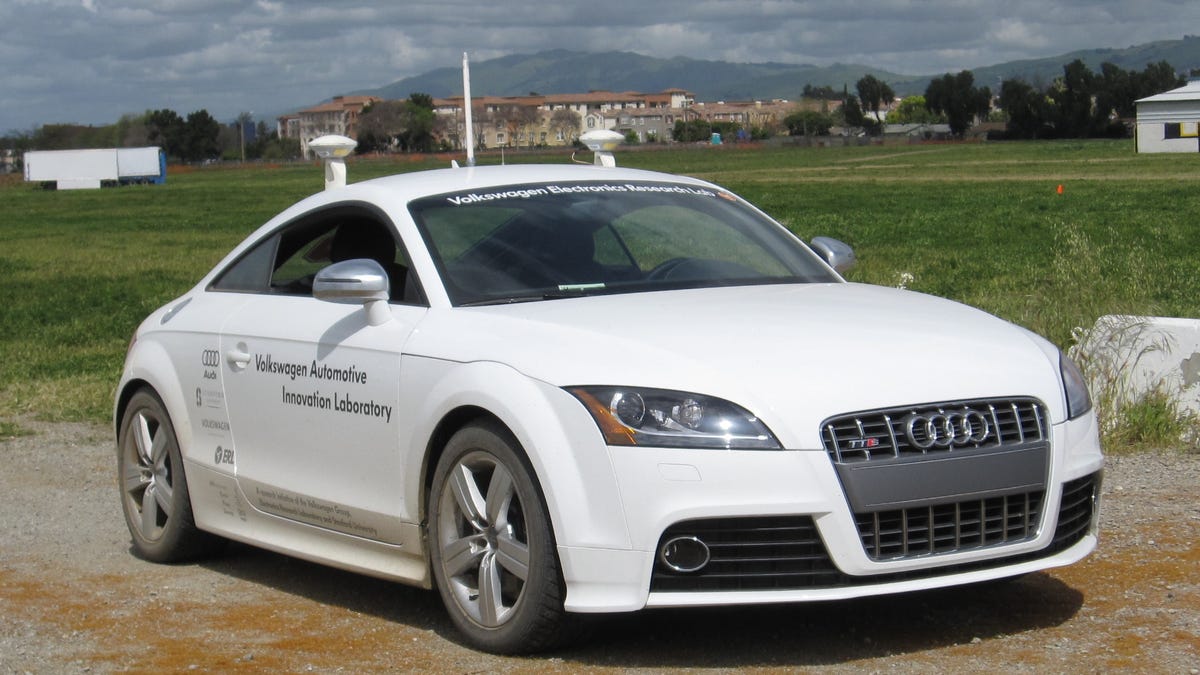Shelley the robot car laps a dirt oval
CNET Car Tech goes along as an autonomous Audi TTS driver laps on a dirt track.

Watching a self-parking car turn the wheel as it backs into a parallel parking spot is a delightfully eerie experience. Sitting in Stanford's driverless Audi TTS as it races up straight-aways and shuffles the steering wheel through turn after turn on a dirt oval makes you believe there's a ghost in the machine.
Stanford's Center for Automotive Research invited us out to a test day, where Professor Chris Gerdes and his team of graduate students sent the driverless TTS, named Shelley, around and around an oval track in an open field. Besides the sheer entertainment value, the team used the laps to collect data on how well the car stuck to its programmed path.
The car is a 2009 Audi TTS, a sport-tuned version of the standard Audi TT, featuring a 2-liter turbocharged direct injection four-cylinder engine, dual clutch transmission, and Audi's Quattro all-wheel drive. Normally that engine produces 265 horsepower, but as the students involved in the project are automotive enthusiasts, they chipped it to 320 horsepower.
High-tech gear sits under the back hatch of Shelley, although it uses surprisingly little computing power. The main processor is a 1.6GHz Pentium 3 housed in a ruggedized case sending commands to individual boards that control steering, braking, transmission, and acceleration. Unlike the DARPA competitors built by Stanford's AI lab for the Grand Challenge and Urban Challenge, Shelley doesn't take in external sensor input to see the landscape. Rather, it uses GPS and an inertial sensor to know where it is in the world.
The purpose of the car is to test autonomous systems that can handle high-speed-driving situations, reacting appropriately to vehicle slide and loss of grip. The Stanford programmers are trying to replicate what a race driver might do as the car slews around corners. The "track" it was driving on during this test day was a string of GPS coordinates fed into it.
The car is a collaboration between the Center for Automotive Research at Stanford, Volkswagen's Electronic Research Laboratory, Oracle, and Sun Microsystems. Volkswagen will look at the results of the testing and the technology developed by Stanford as potential next generation traction and stability control.
As a final test, the Stanford group wants to send the car on a run up Pikes Peak, a tortuous 12.4-mile road up to the 14,000-foot summit. The nickname Shelley comes from Michele Mouton, the first female driver to win Pikes Peak International Hill Climb.
We sat in the car with two members from the Stanford team, one in the driver's seat, ready to take over in case of systems failure and one monitoring the testing on a laptop. The car also has a wireless router in back so it can be programmed and monitored remotely. Rather than set the car's speed, the researchers set a friction number, representing how much slip it would test against.
With the car sitting on the straightaway, the safety driver pushed the go button and the car made an immediate correction to put it on the right line, then accelerated forward. It built up speed until its programming "saw" the GPS coordinate string describe a curve, and realized it needed to start braking to maintain its programmed friction. We watched as the wheel turned in to follow the curve. As the tires began to slip on the dirt surface, the steering wheel shuffled to correct, the car keeping the power on to maintain grip. As it came to the exit of the curve it put more power on in anticipation of the upcoming straightaway.
With this friction-based parameter, the car would keep on accelerating if its programmed path was a straight line. But when it sees a curve in its path, it understands how much braking to apply and how to shuffle the steering wheel, employing techniques such as trail braking and counter steering, to maintain its set friction point. As we rode in the car, the safety driver set a higher friction point, which caused the car to attack each corner more aggressively, building up more speed in the straightaways.
For a practical application, a future safety system based on this research might use GPS to look for curves in the road ahead. If you are driving into the curve too fast to maintain grip, the car might flash a warning to start braking, or even possibly take over braking and steering to bring the car safely through the turn. Technology such as this could prevent drowsy drivers from crashing, and save the lives of countless inexperienced teenage drivers.
There are still many bugs to be worked out. The Stanford researchers were finding that, because of a disparity between the GPS receiver and inertial sensor, the Shelley's sense of where the track was began to slip after a few laps. We saw that, after about 10 laps, the track slipped enough that Shelley was hitting the first turn too far on the outside, and having to cope with driving through grass. The loss of friction on this slicker surface caused the car to slow down drastically as it corrected, trying to get to the next straightaway.
Though Professor Gerdes and his students might seem like cold technologists who want to eradicate the pure joy of driving from this research, the opposite is really true. The students we talked to were enthusiasts who enjoyed track driving, and relished the challenge of building an automated car that could handle a car like a race driver.

